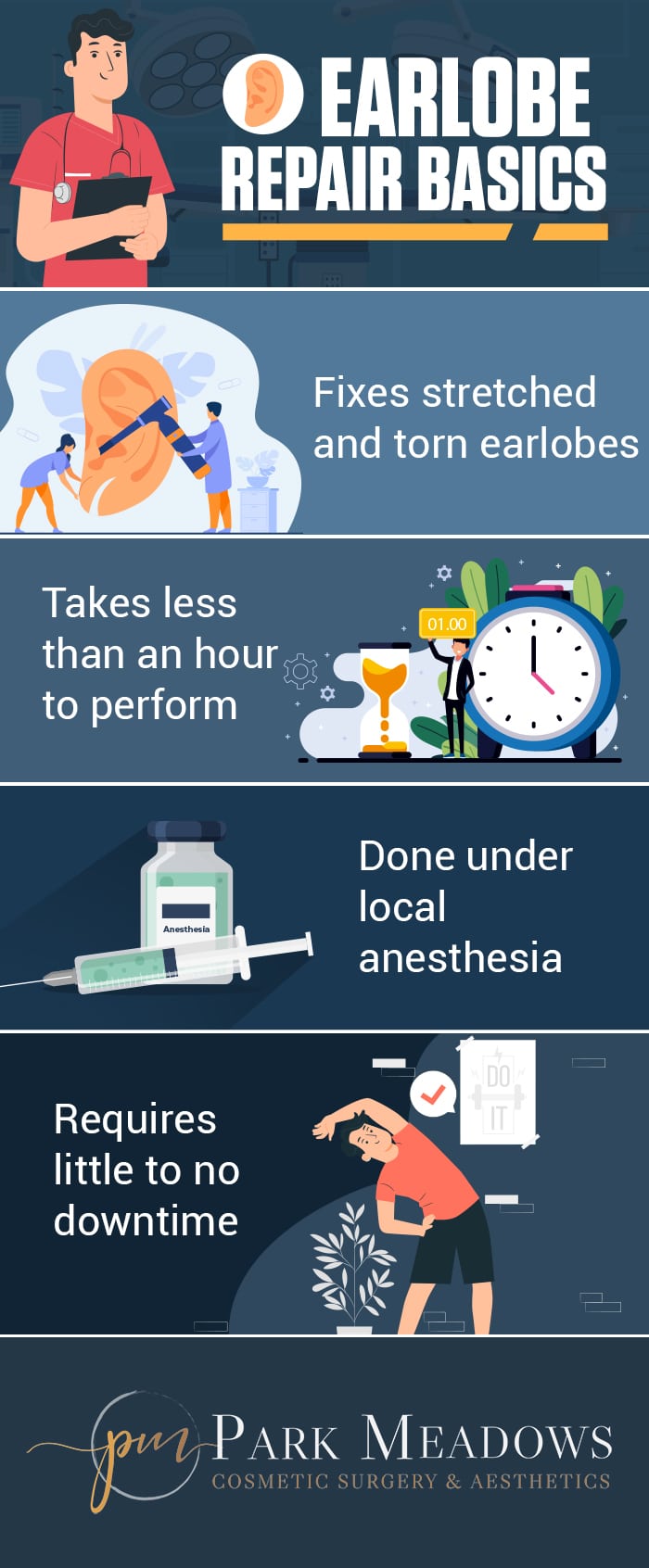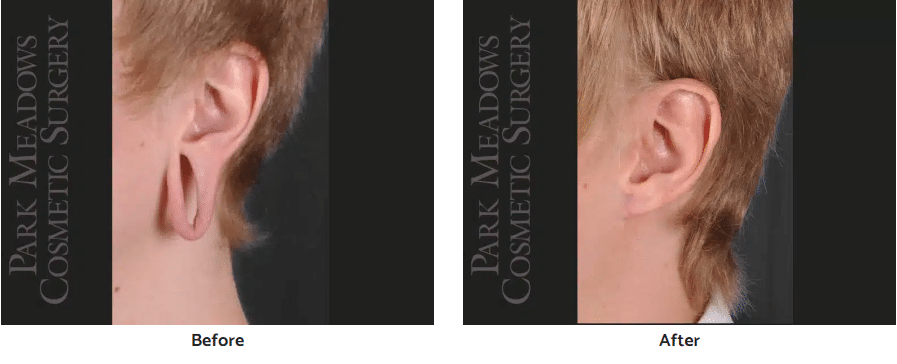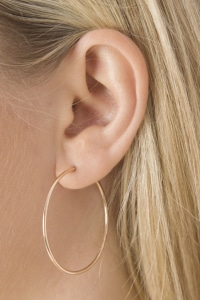Board-Certified Plastic Surgeons Serving Denver & Lone Tree, Colorado
Earlobe repair is a common type of ear surgery with a high patient satisfaction rate. It’s typically performed to correct damage caused by injury or torn-out earrings. It can also restore the normal contour of gauged earlobes.
Fortunately, earlobe repair is a simple cosmetic procedure. It’s usually over in less than an hour and requires no downtime.

Learn if you are a candidate for earlobe repair during a complimentary cosmetic consultation with our board-certified plastic surgeons. Call 303-706-1100 today to schedule your visit. Park Meadows Cosmetic Surgery proudly serves Denver, Lone Tree, and the surrounding areas of Colorado.
Who Is A Good Candidate for Earlobe Surgery?
Ideal candidates for earlobe surgery have:
- Slightly enlarged piercings that are too big to hold a standard stud
- Stretched earlobes from large gauge plug and tunnel jewelry
- Stretched earlobes from age or wearing heavy earrings
- A torn or split earlobe, commonly caused by ripped-out earrings
Even small earlobe imperfections can feel like a big problem. That’s why patients often report improved self-image after surgery. Some gain the confidence to wear pulled-back hairstyles for the first time in years.
How Does The Earlobe Repair Procedure Work?
Earlobe repair is a relatively simple and quick procedure. In nearly all cases, our surgeons perform it using local anesthesia.
Local anesthesia is beneficial for several reasons. It allows patients to see their results and provide feedback before the surgery is over. And unlike patients who receive general anesthesia, patients who receive local anesthesia can drive themselves home.
The exact steps needed to close the stretch or tear can vary. Our surgeons typically create a small notch in the affected earlobe, removing excess tissue if necessary. Then, they meticulously suture the earlobe back together to restore an optimal appearance.
The procedure typically lasts between 45 minutes and 1 hour. Your surgical timing will depend on if you are having one or both ears done, and the extent of your concern.

What Is Recovery Like After Earlobe Surgery?
Earlobe surgery requires minimal recovery. It’s normal to feel a mild throbbing sensation after the anesthesia wears off. This sensation can easily be controlled with over the counter pain medicine. Some patients may require a light narcotic for the day, though this is uncommon.
You won’t need to wear any special dressings after your procedure. However, our surgeons choose not to use absorbable sutures for earlobe repair. Nonabsorbable sutures help minimize scarring. They also allow our surgeons to check your progress when you return to have them removed.

What Are the Benefits of Earlobe Repair?
Earlobe surgery offers a variety of benefits that could make it a great fit for you. If your jewelry options are limited because of an enlarged piercing or tear, earlobe surgery is the first step towards wearing your favorite earrings again. It can also give you the confidence to pull your hair back or go for a shorter cut if you feel self-conscious about the way your ears look.
Earlobe surgery provides immediate results that improve as the area heals. There may be some scarring, but in most cases it’s faint and nearly undetectable. The results of earlobe repair are permanent, though the procedure does not stop age-related aesthetic changes. You can prevent future tears by choosing to wear lightweight studs over heavy dangle earrings. If you do wear large earrings, be sure to remove them in situations where they are likely to catch on something. Also, remove large earrings around children who may be tempted to pull on them.
Additional Earlobe Surgery FAQs

Most earlobe damage happens gradually due to heavy or large earrings. It tends to occur more frequently among people who intentionally gauge their earlobes to accommodate plugs and tunnels.
If you have suffered gradual earlobe damage, you may find that your concerns are getting worse over time. That is because factors such as age and gravity are working against you.
In some cases, torn or damaged earlobes are the result of trauma. Accidents can easily cause splits and other injuries to the earlobe. If an earring gets caught on something, pulled, or tugged, it may result in a tear that can likely be fixed with surgery.
You should be able to return to work or school immediately after earlobe repair surgery. There is little to no downtime involved with this procedure. However, you might experience some temporary tenderness, redness, and bruising.
Earlobe surgery comes with some activity restrictions to support proper healing and good cosmetic results. For example, you will need to avoid strenuous exercise and heavy lifting for four weeks. You will not be able to submerge your ear in a bathtub, pool, or hot tub for four to six weeks. Contact our surgeons if you have any questions about recovering from earlobe surgery.
In most cases, damaged ears do not heal sufficiently without surgical intervention. They can even become infected in the absence of appropriate care.
If you have gauged earlobes, removing your plug or tunnel jewelry will help stop the stretching. Some people can reduce the size of their earlobe by going down in gauge sizes, but many require earlobe surgery to achieve a satisfactory result.
Earlobe surgery does leave a small scar. If your earlobe was severely damaged or you are getting surgery to correct multiple torn piercings, then you may have more than one scar.
Fortunately, it is difficult to detect most earlobe surgery scars after they have healed. Our surgeons use non-absorbable sutures to further minimize scarring. You can help the incision lines fade even more by avoiding unprotected sun exposure for six months after surgery.
Most patients agree that tightening and repairing their earlobes is worth the tradeoff of having a scar. Talk to our surgeons about the results that you may be able to expect.
A repaired earlobe can tear again due to trauma or wearing heavy earrings regularly. You can prevent a future tear by waiting two to six months after surgery before piercing your ears again.
You should get your new piercing above or to the side of your scar to lower your risk of splitting your earlobe. It is also a good idea to stay away from heavy jewelry. The same goes for dangling pieces that can be pulled or get caught on your clothing.

You can get a stretched or torn earlobe re-pierced after earlobe repair surgery with a few limitations. You will need to wait six to eight weeks after your procedure to ensure proper healing. Additionally, our surgeons strongly advise you not to get your ear pierced in the same spot as before.
The scar tissue at the surgical site is not as strong as normal skin. It’s in your best interest to have your ear re-pierced slightly outside of that area.
The cost of your earlobe repair procedure will depend on several factors. These factors include whether you wish to have surgery on one or both ears.
Insurance typically does not cover this procedure as it is considered elective. You can receive an individualized cost estimate by scheduling a consultation at our practice.
Yes, the results from receiving earlobe repair surgery are permanent. However, you should know that this will not affect any changes relating to aging. The entire purpose of this procedure is to correct any holes left by jewelry on the lowest part of the ear. It is a common cosmetic procedure, but it is possible you may need earlobe repair due to trauma.
Yes, earlobe repair can be covered by your insurance. However, it depends on why you are having the procedure done. If you are getting earlobe repair purely for cosmetic reasons, insurance will not cover the cost. You will have to pay for it out of pocket. Insurance will cover the costs if you can verify you need the surgery to treat a traumatic injury, such as an acute tear on your earlobe. An acute earlobe tear is when both sides are split in half. As a result, you will experience bleeding from both sides. Emergency departments typically perform the procedure rather than a plastic surgeon.
As with any type of procedure, you may be worried that it is going to be painful. Fortunately, you will be pleased to know that earlobe repair is not painful. This is because the surgeon will administer a local anesthetic to the target area. You will most likely experience a dull ache once the anesthesia wears off. However, the doctor will provide you with pain medication to keep it under control. During your recovery, you might have some ear sensitivity, which can last for a few weeks. Other common symptoms you may experience during recovery include redness, swelling, tenderness, and bruising. If any of these symptoms become worse, contact your doctor immediately.
Earlobe repairs are very simple, are performed in-office, and generally do not take long to complete. At most, it could take up to an hour to complete, but how long it takes depends on your current situation. There are some cases where the procedure lasts as long as 15 to 20 minutes.
Here are key steps to follow before your procedure:
- Consultation: Share your full medical history, including medications, with your surgeon.
- Medication Adjustments: Some, like blood thinners, may need to be paused—confirm with your surgeon.
- Stop Smoking: If possible, quit several weeks before surgery to support healing.
- Recovery Plans: Arrange for time off and a ride home if taking prescription pain meds.
- Avoid Alcohol: Refrain for 24 hours before surgery to reduce bleeding risks.
For minor earlobe issues, your non-surgical options are limited. In some cases, we can use fillers to temporarily add volume to mildly stretched earlobes, but they won’t repair tears or significant stretching. Non-surgical methods may work if you just want subtle cosmetic improvement rather than structural repair. However, surgical intervention under a local anestheic is typically recommended for the best results.
Yes, your surgeon will aim to restore symmetry if only one earlobe is being repaired. We make careful adjustments to match the size and shape of your healthy earlobe. While there may be minor differences due to natural variations, most patients find the result looks balanced and natural.
Post-Repair Care
After earlobe repair, following a few simple post-care guidelines can support a smooth recovery and help minimize scarring:
- Activity: Light activity is fine right away; avoid strenuous exercise for four weeks.
- Bathing: You can shower 48 hours after surgery, but keep water away from the incision site. Avoid soaking in tubs or pools for a month.
- Medications: Follow your surgeon’s advice on resuming medications. If on pain medication, consider a high-fiber diet to manage side effects.
- Follow-Up: Your first check-up is a week after surgery.
- Contact Your Surgeon: Reach out if you experience unexpected pain, redness, or a fever.
We have more detailed instructions available that we will provide to you after your surgery.
Comparing Earlobe Repair Techniques
Earlobe repair procedures can be tailored to the type and extent of earlobe damage. Here’s an overview of our commonly used methods:
Wedge Resection
In this technique, a small wedge of tissue is removed from the damaged area to create a clean edge for suturing. It’s often used for tears that extend through the earlobe. Recovery tends to be straightforward, though scarring may be more noticeable compared to other techniques, especially in cases of significant tissue loss.
Z-Plasty
Z-plasty involves creating a Z-shaped incision that allows the skin to be rearranged, reducing tension on the scar. This technique can minimize visible scarring and is often chosen for complex tears or those with significant scar tissue from previous repairs. Healing may take slightly longer, but the resulting scar is usually more discreet.
V-Plasty
V-plasty uses a V-shaped incision to reconfigure the earlobe tissue, helping to restore a natural shape with minimal tissue removal. It’s a versatile option that works well for smaller tears and stretched piercings. Recovery is generally quick, and scarring is usually minimal due to the smaller incision.
Each method has its benefits, so the best choice will depend on individual needs, earlobe condition, and cosmetic goals.
Why Choose Park Meadows Cosmetic Surgery?
At Park Meadows Cosmetic Surgery, you’re in great hands with Dr. Jeremy Williams and Dr. Christopher Williams, our two board-certified plastic surgeons who have trained at top institutions, including Johns Hopkins.
Dr. Jeremy Williams, a Colorado native, is known for his approachable style and ability to create natural-looking results. Dr. Christopher Williams brings specialized skills in advanced reconstructive techniques and aims to get the best outcomes for each patient. Together, they offer a level of expertise you won’t find just anywhere.
At our practice, we want you to feel truly comfortable from your first visit to your final check-up. We take the time to listen to what you want, answer your questions, and support you. With our experienced staff and a modern, inviting facility, you can plan to get top-level care.
Schedule Your Denver Earlobe Repair Consultation
Earlobe repair is a quick and relatively painless procedure that can significantly improve various cosmetic concerns. Learn if this surgery is right for you by scheduling a complimentary cosmetic consultation at 303-706-1100. Or, you can fill out the form in our contact page to book your personalized appointment with one of our experienced plastic surgeons. Park Meadows Cosmetic Surgery serves Denver, Lone Tree, and nearby areas of Colorado.
